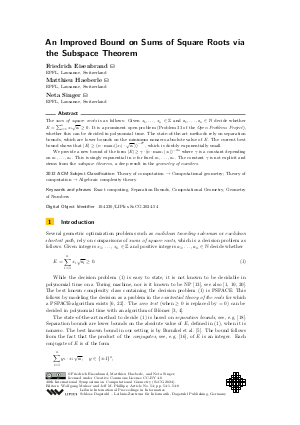An Improved Bound on Sums of Square Roots via the Subspace Theorem
Authors Friedrich Eisenbrand, Matthieu Haeberle, Neta Singer
-
Part of:
Volume:
40th International Symposium on Computational Geometry (SoCG 2024)
Part of: Series: Leibniz International Proceedings in Informatics (LIPIcs)
Part of: Conference: Symposium on Computational Geometry (SoCG) - License:
 Creative Commons Attribution 4.0 International license
Creative Commons Attribution 4.0 International license
- Publication Date: 2024-06-06
File

PDF
LIPIcs.SoCG.2024.54.pdf
- Filesize: 0.55 MB
- 8 pages
Document Identifiers
Subject Classification
ACM Subject Classification
- Theory of computation → Computational geometry
- Theory of computation → Algebraic complexity theory
Keywords
- Exact computing
- Separation Bounds
- Computational Geometry
- Geometry of Numbers
Metrics
- Access Statistics
-
Total Accesses (updated on a weekly basis)
0PDF Downloads0Metadata Views
Abstract
The sum of square roots is as follows: Given x_1,… ,x_n ∈ ℤ and a₁,… ,a_n ∈ ℕ decide whether E = ∑_{i=1}^n x_i √{a_i} ≥ 0. It is a prominent open problem (Problem 33 of the Open Problems Project), whether this can be decided in polynomial time. The state-of-the-art methods rely on separation bounds, which are lower bounds on the minimum nonzero absolute value of E. The current best bound shows that |E| ≥ (n ⋅ max_i (|x_i| ⋅√{a_i})) ^{-2ⁿ}, which is doubly exponentially small.
We provide a new bound of the form |E| ≥ γ ⋅ (n ⋅ max_i |x_i|)^{-2n} where γ is a constant depending on a₁,… ,a_n. This is singly exponential in n for fixed a_1,… ,a_n. The constant γ is not explicit and stems from the subspace theorem, a deep result in the geometry of numbers.
Cite As Get BibTex
Friedrich Eisenbrand, Matthieu Haeberle, and Neta Singer. An Improved Bound on Sums of Square Roots via the Subspace Theorem. In 40th International Symposium on Computational Geometry (SoCG 2024). Leibniz International Proceedings in Informatics (LIPIcs), Volume 293, pp. 54:1-54:8, Schloss Dagstuhl – Leibniz-Zentrum für Informatik (2024)
https://doi.org/10.4230/LIPIcs.SoCG.2024.54
BibTex
@InProceedings{eisenbrand_et_al:LIPIcs.SoCG.2024.54,
author = {Eisenbrand, Friedrich and Haeberle, Matthieu and Singer, Neta},
title = {{An Improved Bound on Sums of Square Roots via the Subspace Theorem}},
booktitle = {40th International Symposium on Computational Geometry (SoCG 2024)},
pages = {54:1--54:8},
series = {Leibniz International Proceedings in Informatics (LIPIcs)},
ISBN = {978-3-95977-316-4},
ISSN = {1868-8969},
year = {2024},
volume = {293},
editor = {Mulzer, Wolfgang and Phillips, Jeff M.},
publisher = {Schloss Dagstuhl -- Leibniz-Zentrum f{\"u}r Informatik},
address = {Dagstuhl, Germany},
URL = {https://drops.dagstuhl.de/entities/document/10.4230/LIPIcs.SoCG.2024.54},
URN = {urn:nbn:de:0030-drops-199993},
doi = {10.4230/LIPIcs.SoCG.2024.54},
annote = {Keywords: Exact computing, Separation Bounds, Computational Geometry, Geometry of Numbers}
}
Author Details
References
-
Eric Allender, Peter Bürgisser, Johan Kjeldgaard-Pedersen, and Peter Bro Miltersen. On the complexity of numerical analysis. SIAM Journal on Computing, 38(5):1987-2006, 2009.

-
Abram S Besicovitch. On the linear independence of fractional powers of integers. Journal of the London Mathematical Society, 1(1):3-6, 1940.

-
Johannes Blömer. Computing sums of radicals in polynomial time. In Proceedings of the 32nd annual symposium on Foundations of computer science, pages 670-677, 1991.

-
Johannes Blömer. A probabilistic zero-test for expressions involving roots of rational numbers. In Algorithms - ESA'98: 6th Annual European Symposium Venice, Italy, August 24-26, 1998 Proceedings 6, pages 151-162. Springer, 1998.

-
Christoph Burnikel, Rudolf Fleischer, Kurt Mehlhorn, and Stefan Schirra. A strong and easily computable separation bound for arithmetic expressions involving radicals. Algorithmica, 27(1):87-99, 2000.

-
John Canny. Some algebraic and geometric computations in pspace. In Proceedings of the twentieth annual ACM symposium on Theory of computing, pages 460-467, 1988.

-
John William Scott Cassels. An introduction to the geometry of numbers. Springer Science & Business Media, 2012.

-
Qi Cheng, Xianmeng Meng, Celi Sun, and Jiazhe Chen. Bounding the sum of square roots via lattice reduction. Mathematics of computation, 79(270):1109-1122, 2010.

- Erik D. Demaine, Joseph S. B. Mitchell, and Joseph O'Rourke. The open problems project. URL: http://topp.openproblem.net/.
-
Kousha Etessami and Mihalis Yannakakis. Recursive markov chains, stochastic grammars, and monotone systems of nonlinear equations. Journal of the ACM (JACM), 56(1):1-66, 2009.

-
J-H Evertse and Roberto G Ferretti. A further improvement of the quantitative subspace theorem. Annals of Mathematics, pages 513-590, 2013.

-
András Frank and Éva Tardos. An application of simultaneous diophantine approximation in combinatorial optimization. Combinatorica, 7:49-65, 1987.

-
Michael R Garey, Ronald L Graham, and David S Johnson. Some np-complete geometric problems. In Proceedings of the eighth annual ACM symposium on Theory of computing, pages 10-22, 1976.

-
Rebecca Hoberg, Harishchandra Ramadas, Thomas Rothvoss, and Xin Yang. Number balancing is as hard as minkowski’s theorem and shortest vector. In International Conference on Integer Programming and Combinatorial Optimization, pages 254-266. Springer, 2017.

-
Narendra Karmarkar and Richard M Karp. The differencing method of set partitioning. Computer Science Division (EECS), University of California Berkeley, 1982.

-
Serge Lang. Algebra, volume 211. Springer Science & Business Media, 2012.

-
Arjen K Lenstra, Hendrik Willem Lenstra, and László Lovász. Factoring polynomials with rational coefficients. Mathematische annalen, 261(ARTICLE):515-534, 1982.

-
Chen Li, Sylvain Pion, and Chee-Keng Yap. Recent progress in exact geometric computation. The Journal of Logic and Algebraic Programming, 64(1):85-111, 2005.

-
Hermann Minkowski. Geometrie der Zahlen. BG Teubner, 1910.

-
Joseph O'Rourke. Advanced problem 6369. American Mathematical Monthly, 88(10):769, 1981.

-
Jianbo Qian and Cao An Wang. How much precision is needed to compare two sums of square roots of integers? Information Processing Letters, 100(5):194-198, 2006.

-
James Renegar. A faster pspace algorithm for deciding the existential theory of the reals. Technical report, Cornell University Operations Research and Industrial Engineering, 1988.

-
Wolfgang M Schmidt. Norm form equations. Annals of Mathematics, 96(3):526-551, 1972.

-
Wolfgang M Schmidt. Diophantine approximation. Springer Science & Business Media, 1996.

-
Claus-Peter Schnorr. A hierarchy of polynomial time lattice basis reduction algorithms. Theoretical computer science, 53(2-3):201-224, 1987.

